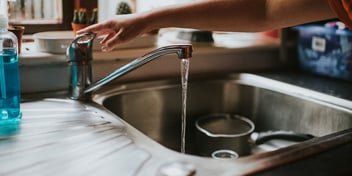Bringing water efficiency to disadvantaged households

A major water utility has supercharged water efficiency efforts in low-income households by tackling a major obstacle — the fact one sometimes has to spend money to save money.
Appliances with the highest energy and water-efficiency star ratings are also the most expensive, often making them unaffordable for people on low incomes.
To overcome this, Sydney Water collaborated with the NSW Department of Planning and Environment, along with a number of regional water utilities, to replace washing machines in households with social disadvantage.
Andre Boerema, Sydney Water’s Drought Program Manager, shared the success of the program at a joint meeting of two of AWA’s specialist members groups: the Water Efficiency Members Group and the Remote Regional and Rural Members Group.
“What we've done for the purpose of this program was to flip the market: make the most efficient machines the cheapest as possible and offer them directly to the houses that needed them most,” said Boerema. “It's been stupendously successful. It exceeded our initial goals.”
He explained that a crucial component of the program was that it operated as a collaboration with the involved stakeholders, ensuring it could draw on a wider pool of expertise as well as funding.
“It was a co-design process, which really unlocked the value for everyone involved — from the regions, and the metro utilities that also participated,” Boerema said.
“That co-design process brought in the value proposition to all the individual regional councils … we're trying to get scales of economy is really what we're trying to do.
“The main disadvantage in regional communities is the tyranny of distance, and the cost of getting expertise, materials, and specialist labour to all these regions. So you've got to try and overcome those very real barriers.”
Community customisation
Other experts who presented at the discussion included Adam Jones, Principal Engineer at BMT, who looked at water efficiency potential for non-residential sites in regional New South Wales, and Damien Postma, Manager of Demand Delivery at Water Corporation, who discussed the utility’s regional water efficiency program.
The importance of adapting solutions to local communities was a theme of Postma’s discussion; he said Water Corporation runs 230 regional water schemes across Western Australia, meaning some careful decisions had to be made.
“One of the big things is, with this program, every town is different,” he said.
“We have to design these programs very specifically for the communities that we're going into, and we still get surprised all the time by some of the results being better or worse than what we expected.
“We’re using our customer insights team to do a lot of work before we go into these towns to make sure we know as much as we possibly can before we design a program and deliver a program.”
One example of this was the significant water savings Water Corporation had helped to bring about in some of the state’s Aboriginal town-based communities, which Postma said were distinct from remote communities.
“They're connected to our town schemes — mainly in the north-west, the Pilbara and the goldfields for us,” he explained.
“The way these communities work is very different to the standard urban setting, and so we have to make sure that our customer programs actually can hit the ground for these people in an appropriate way.
“But overall, over the last eight years, [there was] about a 30% reduction in water use across those communities.”
One source of savings was how the utility approached billing and credits, Postma said.
“We're significantly changing the way that we interact with these customers,” he said. “That has become a real focus, given these are some of the most vulnerable customers we have, and people we can really provide some benefit for.”
Non-residential benefits
Meanwhile, the focus of Jones’s project was on the potential for greater water-efficiency in NSW non-residential sites. Working with non-profit group The Water Conservancy, Jones visited 58 customers across six regions.
“We did site investigations, and we were trying to get a sense for how much water efficiency opportunity there was out there in business and commercial sectors,” he said.
“Then trying to get a sense for barriers and drivers — are there things standing in the way of these businesses and institutions diving in and making these savings?”
His inquiries found consistent opportunities across the different geographical areas, and he predicted an average of 21% of total water use could be saved by the customers.
The next step was to customise his recommendations for each type of consumer. Large customers required a more bespoke approach, Jones said.
“The thing you would do to support them would be detailed audits and assessments, sub-metering advice, feasibility studies,” he explained.
“Smaller businesses, that's the sort of thing to try and scale up, so we are looking at broader support for programs for retrofits, leaks in particular, different kinds of appliances and bathroom fittings.”
For more information on the next Regional, Rural and Remote Specialist Network Member Circle, visit https://www.awa.asn.au/membership-specialist-water-networks/regional-rural-remote-water

